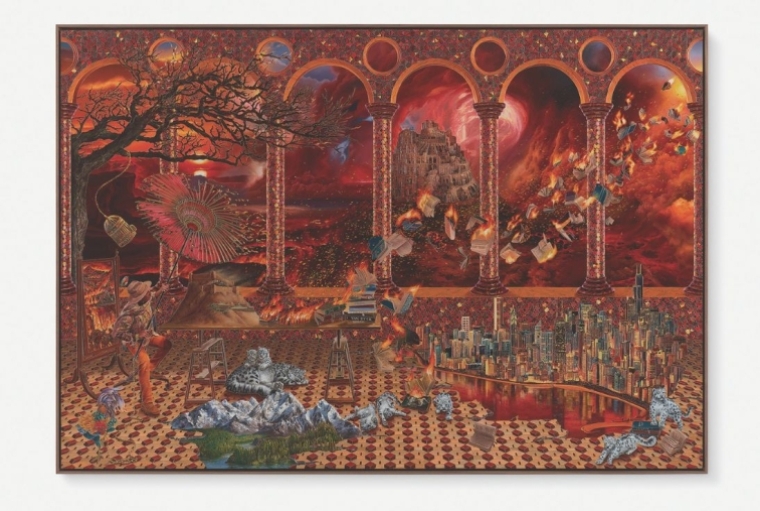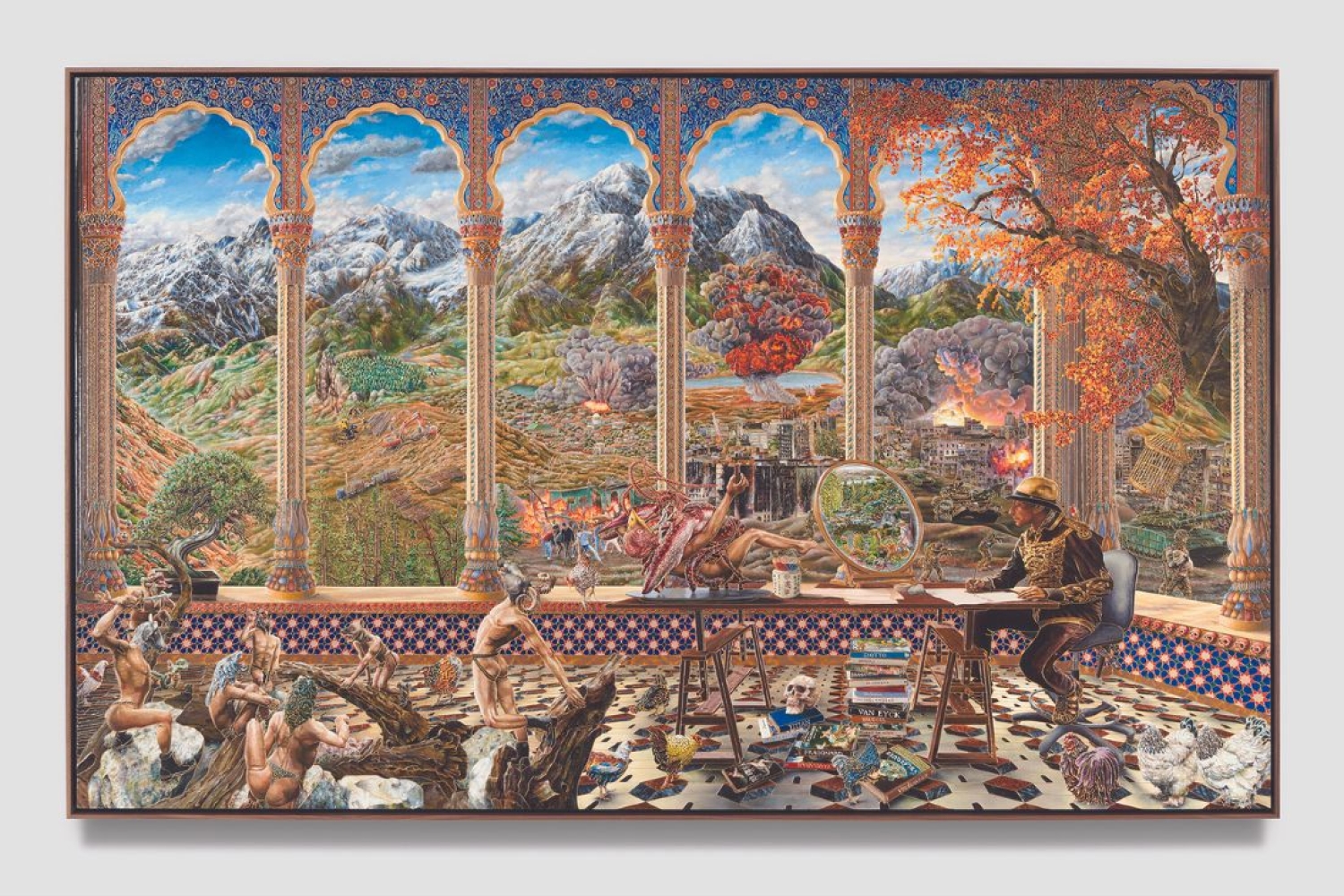

Artists possess the unique ability to be completely, wholly and fully themselves, even as that self is constantly evolving. Evolving, complex and layered. It is very clear, upon entering Raqib Shaw’s studio, which is also his home, that we are about to step into his particular world, visually and emotionally.
Situated in South London, in what was formerly a Sausage factory, the facade suggests a sort of cinematic industrial warehouse, but as one journeys through the space: first through the vast rooms with canvases, stands, equipment, then into into the painting studios with palettes, paper and that smell of freshly applied enamel, and finally into lush gardens with Japanese bonsais, rose bushes and carefully planted exotic flora, one suddenly realizes that we are part of Raqib’s scapes, the world he has constructed through his soaring imagination and his spectacular paintings.
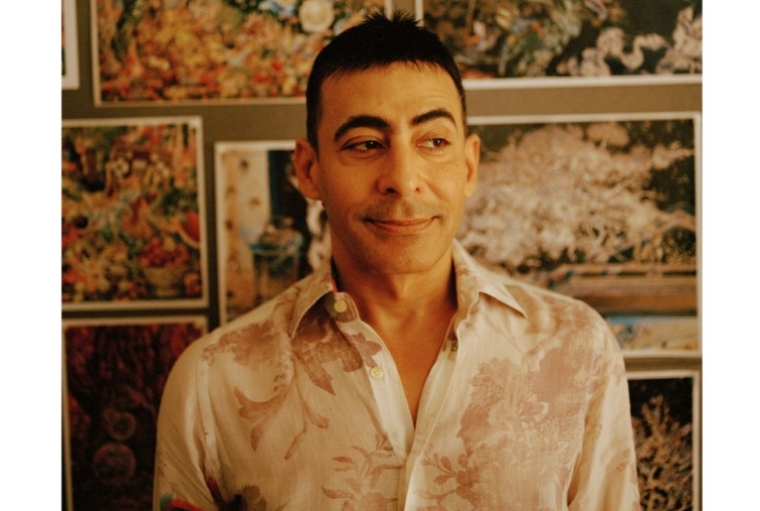
Raqib Shaw
Often, tracing the trajectory of an artists’ career and early years, it becomes apparent that there is not one path, no easy story of influences, mentorship and discovery packaged neatly as a template for learning and success. Born in Calcutta and having lived in Kashmir, Raqib was brought up in a family of merchants, perhaps absorbing the myriad reflections of the objects, art, textiles, and antiques that surrounded him. So much of what we unconsciously imbibe makes its mark in the years to come. A favorite recollection for him were the street booksellers of Calcutta (a city they visited every winter) amongst whose stacked mountain of books he discovered the paintings of the old masters. Tintoretto was an early favourite and remains so. Imagine, if you will, a young Raqib cutting out pages the work of the old masters and plastering his bedroom walls with an explosion of stunning art. Signposts to the future.
Enticed into the family business with promises of merchandising and graphic design, enrolled in an obscure London college, the solitary fine art class he enrolled in made him think of painting as a way forward. Working in the family shop, secretly preparing his portfolio for Central St. Martins College in London, there was very much a feeling of creating a separate universe to inhabit, be fulfilled, and engaged in.
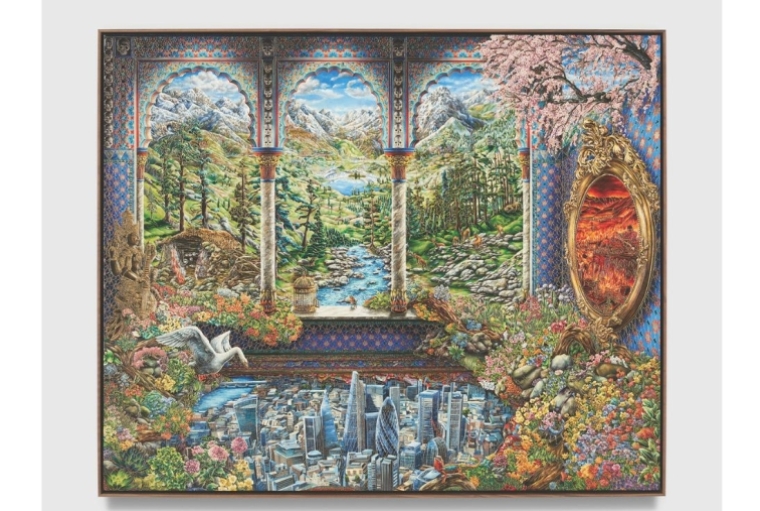
We enter that universe through his paintings. Lush and intricate, flamboyant, and precise, these are meticulously detailed, labour intensive cinematic grand dames. Finding his own medium: a quick drying enamel and metallic industrial paints which he applies with a needle-sharp porcupine quill onto areas of his canvas which have been delineated and defined in gold paint, (an adaption of sorts of the CloisonneÌ technique of ancient times), they evoke the work of the old masters – in particular Bosch and Brueghel. The work is a product of Raqib’s love for mythology, nature, opera, poetry, multi-cultural (both his Eastern and Western influences are apparent) stories, science, and the decorative arts. While the surface is a sumptuous decorative delight constantly pushing the figurative, the underlying themes are erotic and mythical. Born from his deep connection to nature, and his interest in human and animal behavior, the deeply layered references seem oddly familiar and yet entirely unexpected. To this viewer, this work seems like it has been around forever in the same way that a lot of masterpieces now feel familiar – and yet for this artist it has taken over 20 years to develop.
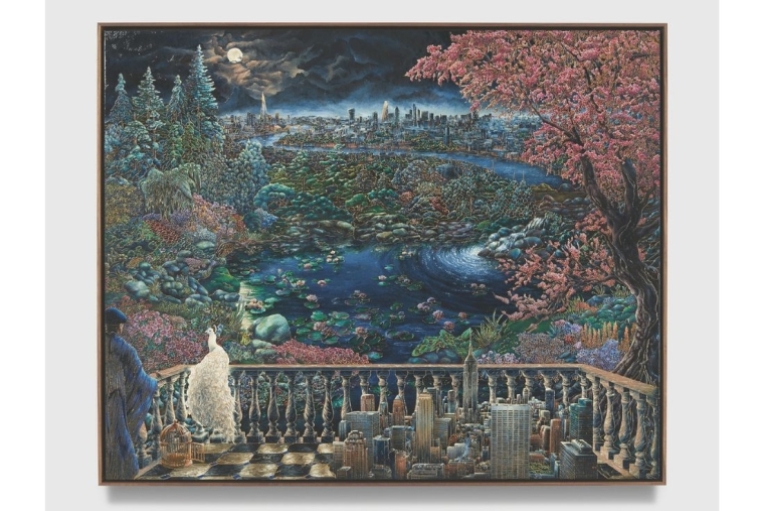
One of the main emphasis of his St. Martins education was for each artist to find “their medium”. His rigour and discipline and exploration of this medium brought him a particular kind of attention – so much so that on the last day of his senior thesis presentation, Victoria Miro Gallery came in to see his work and observe his growth as an artist. Just a couple years after graduating he had his first show for them 'The Garden of Earthy delights': a series of paintings inspired by Hieronymus Bosch. Still working at his 'medium', he almost did not want his paintings to sell so that he could have time to develop his work and technique. It is this complexity and rigor that marks the best of his work.
His love for, and the influences of Japanese culture are apparent: their psychology, philosophy, discipline and ideology. The discipline of making work. That dedication to work. The notion that (for example) if you are a potter, you make hundreds and thousands of pots, and perhaps once, later in life—you make the perfect one. It is a life spent in the pursuit of.
As we walk through the fabulous slice of nature that Raqib has created in and around his home and studio, a Japanese garden here, the entangled English garden there, regimented rows of Bonsais ahead of us, we chat about past, present and his upcoming series of shows in the USA in 2024 and beyond.
As a child he helped his mother with her gardens, her love for trees and flora were passed down to him and he found his solace in nature. His work very much reflects that interplay and each one of his works weaves together the splendor of nature (twisted trees in full bloom, carpets of mushrooms and flowers, rotting fruit in its ripened glory) with sinister mythological creatures and dark and heavily decorative bacchanalia.
His self-portrait series for the Scottish National Gallery of Modern Art (Reinventing the Old Masters 2018) is a perfect example of the best of this aspect of his work. A collection of seven paintings that were displayed alongside two paintings from the galleries collection: Joseph Noel Paton’s The Quarrel of Oberon and Tatiana and Lucas Cranach’s An Allegory of Melancholy. Both these paintings had long fascinated Raqib and in his accompanying series he brought to life his influences and interests while referencing the older masters that he has long admired.
His last show before the pandemic Landscapes of Kashmir (2019 for Pace Gallery), Raqib harked back to his childhood memories of Kashmir and nature, architecture and the emotion of attachment to create a series of paintings breathtaking in their scale and grandeur while pulling us in with the very human details of memory and personal history.
With the world that he has created that surrounds and protects him, Raqib has barely ventured out to travel past the shores of the UK for the past 16 years. Early in his career he was offered the chance to set up a studio in New York City, which he promptly rejected. Too fast, too noisy in contrast to Britain which felt, and still feels small and contained to him, it has a country feel despite its industrial nature, and one can see the sky. This is where he belongs.
However, with a talent at this scale and work that beckons one closer, the world is constantly knocking at Raqib’s door. A series of shows in USA beginning in November 2023 and travelling through Nashville, Boston and Houston through 2024 are upcoming. A collaboration with Dior (his stunning work on their bags) is about to be unveiled, amongst many other new projects.
There is so much to discover about the fabulous Mr. Shaw, and like his paintings – he is a layered complex artist about whom we discover something new every time we speak or every single time we look at his breathtaking work a little closer. The more he creates the more enriched we are.
Words Rymn Massand
Photography Vikram Kushwah
Date 03.02.2024
